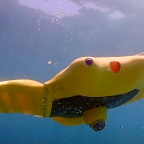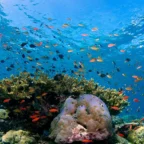
New research has shown how dolphins achieve their blinding speeds.
Gray’s Paradox – named after British zoologist Sir James Gray – proposed that dolphins simply do not have the strength to swim so fast.
But researchers at the Rensselaer Polytechnic Institute in the US have now studied the movement of water around dolphins as they swim.
The results show that dolphins can exert as much as 180kg (400lb) of force with their tails.
Gray had supposed they could produce less than a tenth of this amount, and imagined that something about the dolphins’ skin allowed them to overcome the force of drag in the water and reach high speeds.
“For the first time, I think we can safely say the puzzle is solved,” said Tim Wei, the Rensselaer scientist who led the study.
“The short answer is that dolphins are simply much stronger than Gray or many other people ever imagined.”
To determine this, Professor Wei used a new method of measuring the movement of water that he originally developed to track Olympic swimmers.
The technique employs digital particle image velocimetry, which measures the speed of water movements around a swimming dolphin or human.
Retired US Navy dolphins Primo and Puka were filmed swimming through a tank filled with millions of tiny bubbles.
Software tracked the movement of individual bubbles, determining their speed and direction, and assigning them a colour.
Professor Wei then used force measurement concepts from aerospace research to translate those velocities into a force that the dolphins’ tails were producing – nearly 100kg (200lb) on average.
When “walking” – keeping upright mostly above water with powerful flips of their tails – the dolphins produced as much as 180kg of force.
Professor Wei will go on to study the motion and force generation of other sea animals.
Source: bbc.co.uk












Social Profiles